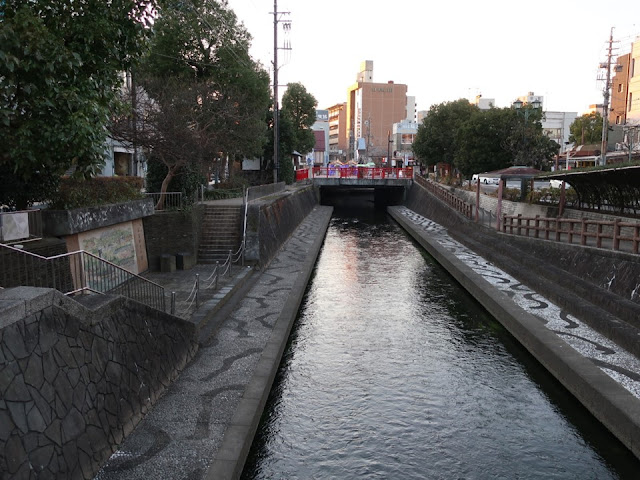It is written, “The castle was used as the headquarters of the West
Army and was one of the fierce battle sites”. It was “Battle of Sekigahara” in
1600. In the following Edo period, Toda clan stationed in the castle and ruled
the area. It is pity that the castle tower burned down in 1945 by airstrike and
was rebuilt in 1959.
Some exhibit panels are written in Japanese plus English.
関ヶ原の東15kmにある大垣城は、西軍を率いた石田三成の本拠地になりました。その後は、譜代大名・戸田氏(十万石)の居城になりました。国宝だった天守閣は太平洋戦争の戦火で焼失したといいますから残念なことです。再建された天守閣には、大垣城での戦さと共に、城下の生活も展示されていて、庶民の生活も少しわかります。
Ogaki is lowland and has suffered from flood. The park went under the water in the past.
大垣は、木曽三川に囲まれた湿地帯。公園になっているところは、洪水で水没したというのですから、大変なことです。
We can see “Sekigahara” from the observatory room of the castle (4th floor).
大垣城4階(展望室)からは関ヶ原が見えます。
It is written, “he (the lord) is said to have actually entered it (castle tower) just once or possibly a few times in his entire life. --- The castle donjon was not built for the lord himself to enter, but as a spectacle displaying statue and beauty to those viewing it from outside.” Got it!
一方、下を見ると殿様になった気分です。が、殿様が天守に登るのは藩主になった時など一生に一度か数度で、内装もしていません。「人々が外から眺めたときにその高さと美しさを誇示できるように建てられていたのです」と書かれています。なるほどねえ。
The castle museum shows us weapons such as armors, swords, bows, matchlock guns and so on.
お城らしく、甲冑だけでなく、刀剣、弓、鉄砲などの武具が展示されています。
“Battle of Sekigahara” is explained in detail including the early skirmish at “Kuisegawa” and the battle at Ogaki Castle. Original anime characters explain; it’s a modern style.
Next, let’s move on to the people’s lives in Ogaki which is the theme of this blog.
関ヶ原の戦いが、前哨戦の杭瀬川の戦いや大垣の籠城戦を含めて詳しく、そして、わかりやすく説明されています。アニメキャラクターを使うのが今風ですね。
それはさておいて、本ブログのテーマである人々の生活に目を向けましょう。
There is a section named “Ogaki’s Castle Town and the Lives of its Inhabitants” where their lives are explained with the old town map. Ogaki has been prospered as a transportation hub of Mino-highway and Suimon River.
「大垣城下と人々の生活」というコーナーがあり、城下の絵図とともに暮らしが紹介されています。大垣は水陸要衝(美濃路の宿場と水門川の港町)として発展しました。
Ogaki has abundant water, whereas the water has caused flood. There are three fountains which have always supplied pure water to the inhabitants even during drought. Ogaki is called “Water City” now. An abacus and a box for letters and papers are exhibited.
Farmers in the Edo period (1603~1868) lived under the severe restrictions; they had to kneel and touch their forehead to the ground when they met samurai; they could wear only cotton clothes (no silk) which color was designated; they couldn’t put on hair ornaments made of silver or bekko (tortoiseshell). It was probably stressful that they couldn’t dress up. Some moved from farming area to Ogaki town; there was a place called a farmer town in Ogaki. I guess they came not only to seek employment, but also to escape from restricted lives as farmers.
城下町に住む町民と農民の生活が説明されています。水が豊かで、同時に水害に苦しんだ大垣では、自然に湧出する平地泉でしたが、その水が使えない時は、三清水と称される三つの泉を使いました。いつも、きれいな水が湧き出す泉があったのですね。今も「水都大垣」と呼ばれています。展示品は、算盤と文箱でした。
農民の暮らしは、藩士への土下座が指示されたり、衣類を木綿に限られるだけでなく、色も限定されるなど厳しく統制されました。銀やべっ甲のかんざしは禁止でした。オシャレをできずストレスが溜まりますね。職を求めて、城下に来た農民が住む百姓町もあったそうですが、統制が嫌で出てきた人もいたのかも。
Samurai’s lives were also restricted, however poetry flourished due to the lord’s educational policy. Matsuo Basho (1644~1694), who was the greatest haiku (short poem) creator, ended his five-month trip at Ogaki. The haiku he created while traveling were published as “Oku no Hosomichi” (The Narrow Road to the Deep North). There is Basho’s Oku no Hosomichi Haiku Journey Museum in Ogaki. It was a peaceful time and people enjoyed haiku.
Reference: Basho memorial museum 芭蕉記念館
The exhibits are kanzashi (hair ornaments) and making-up tools for married women.
武士の生活も統制されましたが、藩主の文教政策の影響で、俳句が盛んでした。松尾芭蕉が約五ヶ月の「奥の細道」の旅を終えて水門川の舟で桑名に向かったということで、「奥の細道むすびの地記念館」が建てられています。平和な時代だから、楽しみがないとね。
展示品はかんざしとお歯黒染めの用具です。
Belongings of samurai. Inrou (medicine case), a round fan and a telescope in front. Horsewhips and an arrow case in behind. Those are excellent crafts.
武士の持ち物。前列は印籠、団扇、遠眼鏡、後列は矢筒と鞭です。いい品ですね。
Suimon River, which was prospered by the water transportation, is a calm channel where citizens relax now.
水運で栄えた水門川は今は静かな水路になっていて、大垣の街の憩いの場所になっています。
Visited in January, 2022
Official website: https://www.city.ogaki.lg.jp/0000000577.html
(in Japanese), accessed in May, 2022
Previous post (House in Waju river island in Ogaki): Waju-life museum、輪中生活館
Next post (Museum beside Ogaki Castle): Ogaki local museum、大垣市郷土館










Comments
Post a Comment